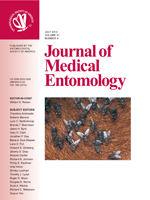The effects of azadirachtin A added to the sucrose diet of the adult females on the mortality, oviposition, and hatching of the sand fly vector of American visceral leishmaniasis Lutzomyia longipalpis (Lutz & Neiva, 1912) were investigated. Concentrations of 0.1, 1.0, and 10.0 μg/mg of azadirachtin significantly increased insect mortality in comparison with control insects. The same dose also significantly reduced oviposition but not hatching. After a long development period, significantly fewer adult insects were obtained from eggs hatching by azadirachtin-treated females in a doseresponse manner. These results indicate that azadirachtin is a potent sterilizer that could be used against the development of Lu. longipalpis populations and as a tool for studying physiological and biochemical processes in phlebotomine species.
How to translate text using browser tools
1 July 2014
Effects of Azadirachtin on the Biology of Lutzomyia longipalpis (Diptera: Psychodidae: Phlebotominae) Adult Female, the Main Vector of American Visceral Leishmaniasis
Cláudia Alves De Andrade-Coelho,
Nataly Araujo De Souza,
Vanderlei Campos Silva,
Adelson A. Souza,
Marcelo Salabert Gonzalez,
Elizabeth Ferreira Rangel
ACCESS THE FULL ARTICLE
It is not available for individual sale.
This article is only available to subscribers.
It is not available for individual sale.
It is not available for individual sale.

Journal of Medical Entomology
Vol. 51 • No. 4
July 2014
Vol. 51 • No. 4
July 2014
azadirachtin
Lutzomyia longipalpis
vector control




